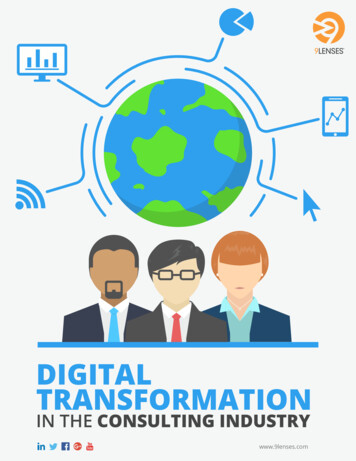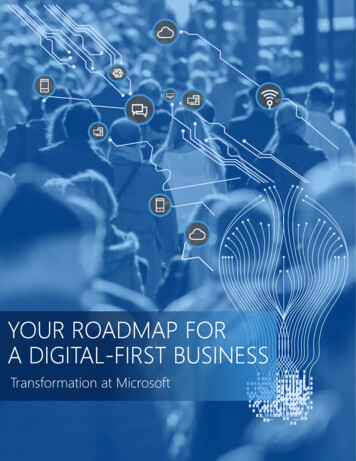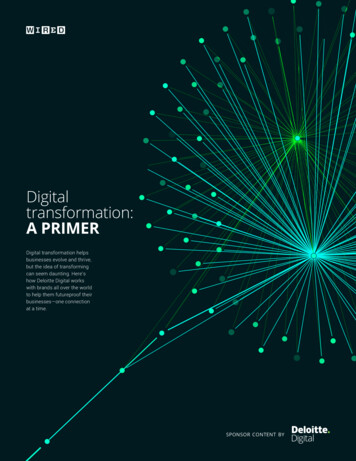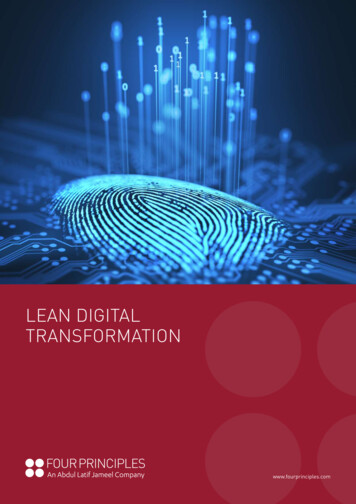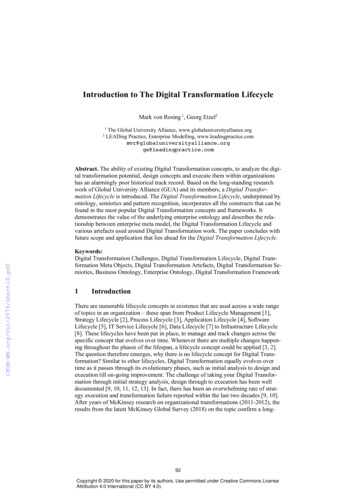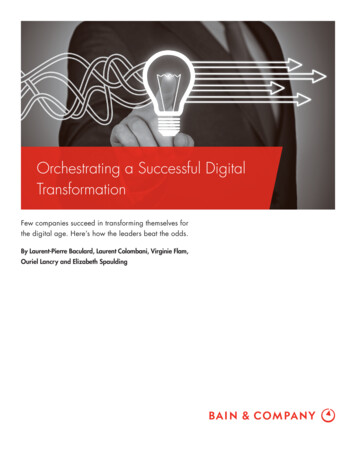
Transcription
Orchestrating a Successful DigitalTransformationFew companies succeed in transforming themselves forthe digital age. Here’s how the leaders beat the odds.By Laurent-Pierre Baculard, Laurent Colombani, Virginie Flam,Ouriel Lancry and Elizabeth Spaulding
Laurent-Pierre Baculard leads Bain Digital Transformation in Europe, theMiddle East and Africa, where he is the regional Digital practice leader. Heis a partner in Bain’s Paris office. Laurent Colombani is a Bain partner, andVirginie Flam is a principal. Both are based in Paris. Ouriel Lancry andElizabeth Spaulding are coleaders of Bain’s Global Digital practice. Ouriel is apartner based in Chicago, and Elizabeth is a partner based in San Francisco.Repeatable Models is a registered trademark of Bain & Company, Inc.Copyright 2017 Bain & Company, Inc. All rights reserved.
Orchestrating a Successful Digital TransformationWhen Bain & Company recently surveyed 1,000 companies around the world to gauge their level of digitalreadiness, two things became abundantly clear: Thepayoff from digital transformation can be impressivelyhigh, but the success rate is regrettably low.more than twice as fast as those at digital laggards.Profit followed a similar pattern—leaders were nearlytwice as likely as laggards to increase profit. Thesefindings leave little doubt that digital transformationcan yield significant results.This gap between aspiration and reality may help explainwhy a surprising number of leadership teams remaintentative about investing in digital technologies andcapabilities. While a strong majority of companies inevery industry we surveyed told us that digital investment is among their top priorities, anecdotal evidencesuggests that a great many executives are skeptical thatthey can translate the buzz around digital into meaningful improvements in performance.Capturing those gains is another story. The data showsthat digital transformations are significantly harderthan conventional change management programs(see Figure 1). In our survey, just 5% of those companies involved in digital transformation efforts reportedthat they had achieved or exceeded the expectationsthey had set for themselves (vs. a success rate of 12%for conventional transformations). A full 75% of thesecompanies settled for dilution of value and mediocreperformance.What’s clear from the data, however, is that the prize isthere for the taking. Digital leaders in every industryoutperform their competition by a wide margin. Aftercomparing financial results for five categories ofcompanies based on their degree of digital sophistication, we found that revenues at digital leaders grewWhat goes wrong? The typical digital transformationeffort founders on the sheer complexity of using technology to increase a company’s speed and learning atscale. Even if some traditional companies are used toinnovating in the product development realm, few areFigure 1Digital transformation efforts are significantly more challenging than othersIn a study of hundreds of companies executing major changes Conventional transformationDigital transformation12%Achieved or exceededexpectations5%20%Failed to deliver, producing lessthan 50% of the expected results20%Failed to deliver, producing lessthan 50% of the expected results68%Settled for dilution of value andmediocre performance75%Settled for dilution of value andmediocre performanceSource: Bain risk history survey 2017 (n 403); Digital 360 Barometer survey 2017 (n 1012)1Achieved or exceededexpectations
Orchestrating a Successful Digital Transformationadept at rapidly deploying digital technologies to solveproblems and boost performance across the organization. Most leadership teams understand the opportunity but underinvest in the broad changes to the business model and culture that enable speed, learning andagility. They focus more on what we call the “outergame” of digital investment—“Should we work on customer engagement or the supply chain?”—and less onthe “inner game”—“Do we know how to choose theright investments, test them in real time and scalethem for maximum impact?”struggle to translate these prototypes into productsand capabilities that can have a meaningful impact onthe company’s economics. More advanced businessesdo a good job of clustering digital initiatives around acommon strategic ambition and start to focus on improving select enabling capabilities, particularly IT.But these initiatives also tend to plateau somewhereshort of broad organizational impact or end up creating “two-speed” organizations that are responsive inlimited respects but still held back by legacy systems.The true digital leaders pull away from the competitionby linking a bold strategic ambition to the specific innergame capabilities and behaviors that they will need toachieve it. First they translate their strategy into a clearset of digital initiatives that point the organizationtoward a clear vision of full potential. Then they investheavily in the fundamental changes to their ways ofworking and culture that allow them to develop thoseinitiatives rapidly and execute them at scale.Winning is about inner-game orchestrationAmong the five categories of companies in our research,the most advanced digitally achieved the best balancebetween the inner and outer games (see Figure 2).Those just embarking on digital transformations typically start from a set of isolated initiatives targetingtheir most acute pain points (the outer game), but theyFigure 2A company’s level of digital competence depends on how well it balancesthe inner and outer cted15% are17% are29% are43% are62% arefinancial leaders financial leaders financial leaders financial leaders financial leadersBenefiting frompockets of digitalactivity but lackan outer game—anoverarching strategy.Poised to mobilizethe outer game—an emerging strategy—with nascentdigital initiatives.Have adopteddigital technology andmethods, but onlypartially across thecompany.Source: Bain & Company Digital 360 Barometer Survey, 20172Ready to scaleup digital initiatives,with the support of astrong inner game.Positioned as digitalleaders in theirindustry, propelledby strong inner andouter games.
Orchestrating a Successful Digital Transformationto work. The challenge is figuring out how to harnessthose ideas into a coherent set of strategy-based initiatives that can have broad, meaningful impact. Ideascome from everywhere—the center, the business units,the front line, partners. But if left to grow in their owncorner of the organization the result is typically a welltailored local solution that is rigorously unscalable tothe rest of the company. Great orchestration boils downto a system that identifies the ideas with the mostpotential to have enterprise-wide impact and then ralliesthe organization around them, top to bottom. This requiresa coordinated effort at all levels of the corporation—alignment at the top, agility in the middle and mobilization at the front line (see Figure 3).If this sounds like a recipe for ripping up everything atonce, it often is—digital transformation involves changeat every level of the organization. But careful and deliberate orchestration makes the problem manageable.These interconnected companies learn to break bigideas down into well-defined waves of practical, achievable stepping-stones that offer steady, incrementalprogress. They create what amounts to a digital factorythat industrializes the process—prioritizing the bestideas, nurturing them, testing them and ultimatelyscaling them into game changers. Collectively thesewaves of innovation build to sustained levels of superior performance over time. They allow for headwayacross many fronts simultaneously without overwhelming the organization.Less is more: Alignment at the topThe three things great orchestrators doAny discussion of strategy begins with making surethat everybody is on the same page. So it’s no surprisethat our survey respondents cited executive alignmentGreat orchestrators recognize that most companiesaren’t lacking in ideas about how to put digital technologyFigure 3Orchestration requires alignment at the top, agility in the middle andmobilization at the front lineSecure bold alignment at the top by using strategic imperatives—notdivisional priorities—to set the digital agenda. Ring-fence sharedresources to support it.Take critical initiatives from prototype to scale by overinvesting indigital factories that rely on Agile ways of working.Recruit the front line as conveyors of change by building a virtualcommunity that focuses on innovation and learning.Source: Bain & Company3
Orchestrating a Successful Digital Transformationas the No. 1 factor in successfully executing a digitaltransformation. In our experience, however, alignmentis a loose concept. Agreement on broad strategic principles can often mask sharp disagreements over thespecifics. It’s relatively easy, for instance, to agree onwhich direction digital is taking your industry, but infinitely harder to forge alignment around how to prioritize particular initiatives and support them with theright resources. This is because each member of theexecutive committee typically focuses on his or herown digital agenda—the business units focus on market issues, IT is preoccupied with worn-out legacy infrastructure, human resources is all about behaviorchange, and so on. There’s also natural tension between the corporate center and the rest of the company, which often tends to think the top executives areremote and out of touch with what’s really happeningin the market.the most important priorities rather than spreading resources evenly across everyone’s pet project. The key isto use real-world data to establish alignment so the entire team agrees on how to execute at the front line.That forces business unit chiefs to cast off the “what’sbest for my organization” agenda and embrace a newperspective: “How can my organization contribute to across-functional effort to bring this critical set of digitalinitiatives to life?”When one advertising company decided to accelerate itsmarch into the digital realm, for instance, all membersof its leadership team could agree that digital was forever changing how they interacted with customers. Buteveryone saw the challenge ahead from a different perspective. Should the company revamp its product suiteto match the rise of social marketing? Should it develop self-serve and automated digital channels to complement how it normally interacts with advertisers?How much and how fast should the company buildnew business models to take advantage of Big Data?In markets roiled by digital disruption,companies need a fast process for bothsurfacing great ideas and getting behindthe right ones.To find a way to agree on the right priorities, the leadership team decided to shift its viewpoint. They developeda set of tangible customer personas and identified whatcritical pain points each one would encounter across avariety of typical customer “episodes.” Once everybodywas looking at things from the customer’s point ofview—not their own—it became obvious how digitalshould improve the customer experience. This allowedthe executive committee to break down concepts intosmaller, actionable initiatives, complete with a plannedsequence and an estimate of expected returns. This ensured that their inspirational vision matched the harshfinancial realities of the advertising business.The right kind of alignment bridges these gaps byconfronting a fundamental challenge—the best ideasfor game-changing initiatives most often come fromdeep within the organization, but their success dependson the ability of top executives to spot them, elevatethem and support them with the right kind of investment. In markets roiled by digital disruption, companies need a fast process for both surfacing great ideasand getting behind the right ones.Forging this kind of agreement is the first step in creating real alignment. Making sure everyone remainscommitted to that vision is the second. For one globalbusiness-to-business (B2B) service company, thatmeant using its long-established budgeting process toring-fence and protect the resources needed to achievethe company’s agreed-upon digital ambition. Each executive committee member pledged to increase his orThis typically requires critical changes to corporate behaviors. The most effective leadership teams learn howto establish a common understanding of priorities andallocate resources against them based on clear rulesand governance—rules that emphasize gang-tackling4
Orchestrating a Successful Digital Transformationher cost-management goal to create a discrete pool ofinvestment capacity that they entrusted to the chiefdigital officer. The digital organization could then usethese funds to seed actual in-market digital endeavorsthat fit the new digital agenda. This approach allowed alarge corporation, burdened with the typical quarterlyreports and cash generation objectives, to behave morelike an Alphabet or Facebook, using its well-oiled corebusiness to fund riskier initiatives aimed at futuregrowth.putting a “minimum viable product” in front of customers quickly and improving it incrementally basedon real-world customer data. Unless the effort is timeboxed in this way, teams naturally gravitate back toward the big-company habit of overdesigning solutionsthat are obsolete upon delivery. This burns precioustime and resources.What’s critical is to give the team authorityto make decisions across functions andgive it a strict set of deadlines to follow.The digital factory: Agility in the middleAs important as alignment is at the top, the actual workof developing and scaling digital initiatives takes placein the middle of the organization. Great orchestratorsassign initiatives to cross-functional teams that use Agile development processes to test prototypes with customers, learn from real-market experience and adaptas necessary in a rapid cycle of continuous improvement and scaling. These aren’t innovation labs in thetraditional sense, because they don’t stop with a winning prototype. They are more like factories: They takeraw material (the organization’s most promising digital initiatives) and process it via test-and-learn cyclesinto Repeatable Models that can be scaled acrossthe enterprise.It’s no surprise that these Agile ways of working haveproliferated at digital native companies whose majorproducts are software based. For them, testing andscaling new initiatives is relatively easy. Spotify, forinstance, tests new features directly in its core softwareengine via smart coding and then rolls out the winners across its platform when they are ready—a quickand effective way to make incremental changes thatadd up to major enhancements over time. A traditionalbrick-and-mortar organization, on the other hand,faces hundreds more barriers and long-establishedindustrial processes.This design and scaling process begins with problemdefinition. Very often it involves taking a particularlyimportant customer journey and breaking it down into“moments” that could be significantly improved via digitalinnovation. Because digital initiatives most often cutacross organizational boundaries, speed of executionrelies on bringing the right mix of capabilities to bearon a specific challenge. People from, say, marketing, ITand finance may need to be in the same room as thosewith expertise in data analytics or user-interface design. If those skills aren’t readily available, it may beimportant to round up expertise from the outside.Consider the example of a food-service operatorlooking to offer cafeteria customers a way to placelunch orders in advance via smartphone. This couldchange its business model significantly by automatingmany aspects of the current process and considerablyreducing queues at the point of sale. But it wouldalso mean rewiring successful systems and behaviors (of both employees and customers) that hadbeen honed through decades of smoothly runningthe traditional business—a risky and potentially disruptive proposition.What’s critical is to give the team authority to makedecisions across functions and give it a strict set ofdeadlines to follow. This enforces the Agile concept ofThe answer was to break the smartphone initiative intosmaller steps and test it in discrete local markets with5
Orchestrating a Successful Digital Transformationthe intent of scaling a successful prototype incrementally.The company started by rolling out menu informationon an app to test customer appetite for smartphonebased interactions. It also began to measure the degreeof internal change required to make the initiative work.After implementing and testing Step 1 at the local level,it then rolled out the pilot to a meaningful set of othersites, where the team could gather data to further refinethe model and see whether it improved return on investment (ROI) at scale. That learning supported thelaunch of Step 2 at the original sites, which then supported the launch of Step 3. Eventually, some of thecompany’s early sites were deep into Step 4 or 5, whileothers were just embarking on Step 1. In this way, thecompany was able to go wide and deep at the sametime, learning from real experience, adapting the business model as necessary and scaling an increasinglysophisticated offering step by step.converts among frontline stars, who can then evangelize the change among their peers.A digital community is more like a netthan a chain. It is less hierarchical andmore informal, which plays to the skillsof a young, digitally savvy workforce,giving it a better chance of inspiring thekind of viral buy-in that helps ideas scalemore organically.Populating the digital factory’s Agile teams with frontline leaders is one of the most tangible ways to recruitexpertise from those closest to the customer. But thebest orchestrators also reenvision how communicationworks within the enterprise. The food-services company, for instance, has built an intracompany social network using Facebook’s Workplace platform. It hasevolved into a vital two-way information conduit between leadership and the rest of the company’s operations. This helps the executive team orchestrate andmanage change from the top down, but it also conveysa stream of market intelligence, organizational learning and new ideas from the bottom up. The network isas much about communicating the digital transformation strategy as it is about monitoring the weak signalsfrom the market that can potentially help shapethat strategy.This last point is essential because the fundamental assumption behind the digital factory is that you willnever reach the later steps of the rollout plan as initially envisioned. By the time you get there, the initiative will have morphed many times over based onchanging market conditions or encounters with organizational reality. In this case, the process itself is flexible because it is based on iterative cycles of test-andlearn that move closer in successive steps to anever-changing target.Embedding change: Mobilization at thefront linePerhaps the surest way to upend this virtuous cycle ofdigital innovation is to underinvest in mobilizing thefront line. Survey respondents cited this as the biggestpotential threat to a successful digital transformation.The typical change initiative gets cooked up at the executive level and pushed down to an often reluctantorganization. Successful orchestration, on the otherhand, recruits important people on the front line toplay a leadership role in developing and executing thedigital agenda. This has two critical benefits. It taps theexpertise of those closest to the customer and winsThis virtual community is essentially a sponsorshipspine tailored for a digital world. Traditional sponsorshipspines support the change effort by creating a chainof mentors and change agents at every level of theorganization. But a digital community is more like a netthan a chain. It is less hierarchical and more informal,which plays to the skills of a young, digitally savvy workforce, giving it a better chance of inspiring the kind ofviral buy-in that helps ideas scale more organically.6
Orchestrating a Successful Digital TransformationFor the outer gameTo build the community, leadership started by enrollingemployees who were already excited about digitalchange. Then it hired a full-time community managerto mobilize these early adopters, while working onstrategies to enroll others and increase their level ofengagement. The idea was to target the company’srank and file with the same sort of approach a socialmedia manager would use to increase engagementwith customers on the outside. Once at scale, the network has become a platform for multiple initiativesthat spanned geographies and business units. It hashosted an internal innovation contest to source disruptive ideas from the company’s would-be “intrapreneurs” and a program to celebrate experiments andsuccesses. The company hopes to build it into a broadpeer-to-peer platform for sharing learning on issueslike operational efficiency, the company’s environmental footprint and employee safety. The idea is tocreate a living place to gather and distribute the company’s combined experience and intellectual capitalin an open platform akin to Google’s “share everything” approach. Are we at the forefront of the digital curve inour industry? Would we know it if we were lagging behind? Do we have a clear vision of where the industry isheaded digitally and how we can build or sustainleadership in that context? Are we tapping digital innovation to create new,distinctive experiences that give existing customers what they want and to help develop new ones? Do we know how value will be created tomorrowand what that will require in terms of high-velocitybusiness models, talent and capabilities?For the inner gameFew companies are succeeding so farat transforming themselves to lead theirindustries in a digital age. But those thathave achieved leadership are reapingsignificant financial rewards.Few companies are succeeding so far at transformingthemselves to lead their industries in a digital age. Butthose that have achieved leadership are reaping significant financial rewards. These leaders will tell you thatorchestrating a successful digital transformation is amultiyear journey. But it begins by asking a few questions about what it takes to succeed at both the innergame and the outer game. Have we managed to extract measurable benefitsfrom our digital investments? How many of ourprototypes have actually made it to the market—at scale? Are we as an executive team really aligned behinda common digital ambition, or are we competingfor resources under a broad “catchall” vision? Are we building alignment and engagement deepwithin the organization, and are we learning fromthe front line? Are we investing to build an Agile, adaptive operating model and robust capabilities to support ourvision, or are we creating a “two-speed” organization with limited impact on our core business?Honest answers to these inquiries will begin to shine alight on where your company is in its digital evolution.That, in turn, will help you diagnose how preparedyour team is to orchestrate a successful digital transformation. The companies that are using digital technology and innovation to pull away from the competitionare those that are willing to commit to real change in7
Orchestrating a Successful Digital Transformationhow they work, how they learn from the fast-movingmarket and how they mobilize large organizations toscale their best ideas.Most of all, they recognize that sitting still is not an option—the time is now to progress down the learning curvetoward becoming a connected digital leader.8
Shared Ambition, True ResultsBain & Company is the management consulting firm that the world’s business leaders cometo when they want results.Bain advises clients on strategy, operations, technology, organization, private equity and mergers and acquisitions.We develop practical, customized insights that clients act on and transfer skills that make change stick. Foundedin 1973, Bain has 55 offices in 36 countries, and our deep expertise and client roster cross every industry andeconomic sector. Our clients have outperformed the stock market 4 to 1.What sets us apartWe believe a consulting firm should be more than an adviser. So we put ourselves in our clients’ shoes, sellingoutcomes, not projects. We align our incentives with our clients’ by linking our fees to their results and collaborateto unlock the full potential of their business. Our Results Delivery process builds our clients’ capabilities, andour True North values mean we do the right thing for our clients, people and communities—always.
Key contacts in Bain’s Digital practiceAmericasNathan Anderson in Chicago (nathan.anderson@bain.com)Greg Caimi in San Francisco (greg.caimi@bain.com)Lucy Cummings in Washington, DC (lucy.cummings@bain.com)Ouriel Lancry in Chicago (ouriel.lancry@bain.com)Ryan Morrissey in Chicago (ryan.morrissey@bain.com)Tom Shannon in Chicago (tom.shannon@bain.com)Elizabeth Spaulding in San Francisco (elizabeth.spaulding@bain.com)Asia-PacificFlorian Hoppe in Singapore (florian.hoppe@bain.com)Arpan Sheth in Mumbai (arpan.sheth@bain.com)Europe,Middle Eastand AfricaLaurent-Pierre Baculard in Paris (laurent-pierre.baculard@bain.com)Laurent Colombani in Paris (laurent.colombani@bain.com)Virginie Flam in Paris (virginie.flam@bain.com)Torsten Lichtenau in London (torsten.lichtenau@bain.com)Oliver Straehle in Zurich (oliver.straehle@bain.com)For more information, visit www.bain.com
payoff from digital transformation can be impressively high, but the success rate is regrettably low. This gap between aspiration and reality may help explain why a surprising number of leadership teams remain tentative about investing in digital technologies





